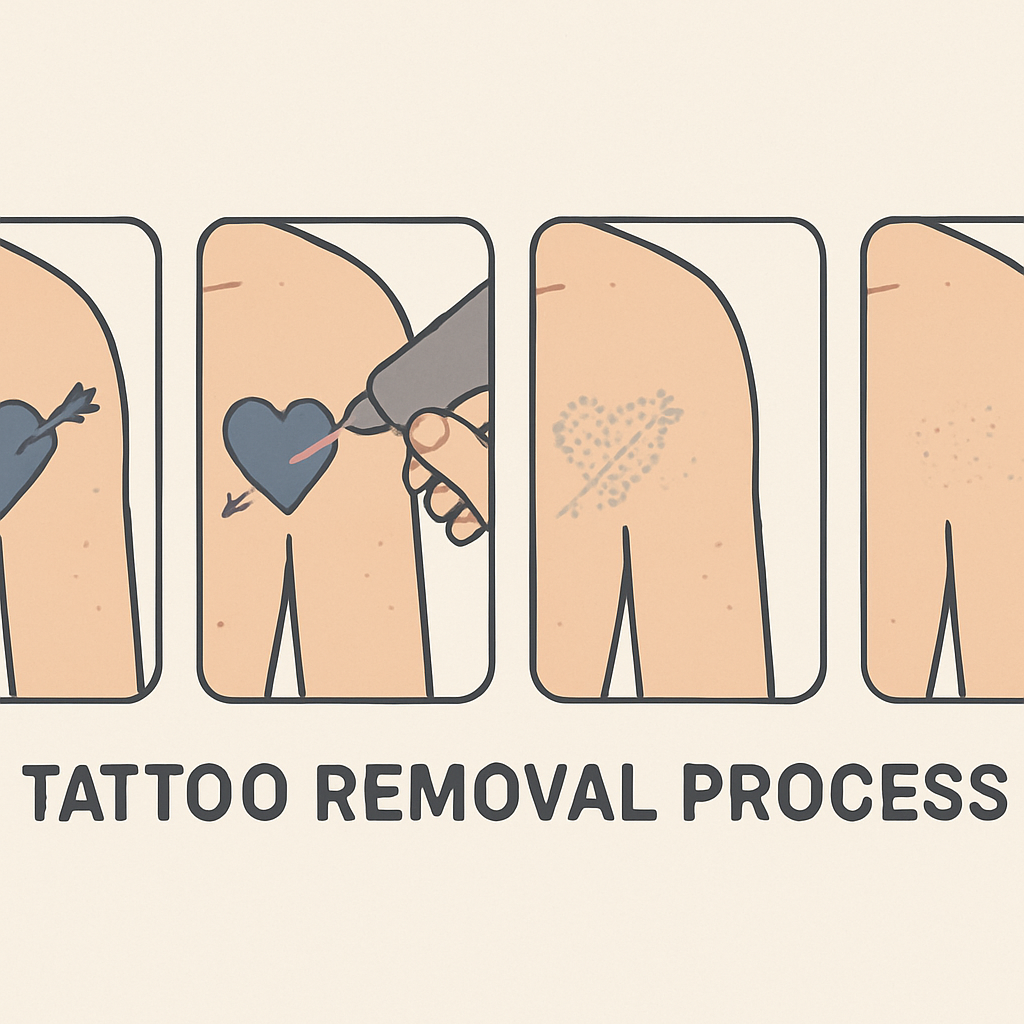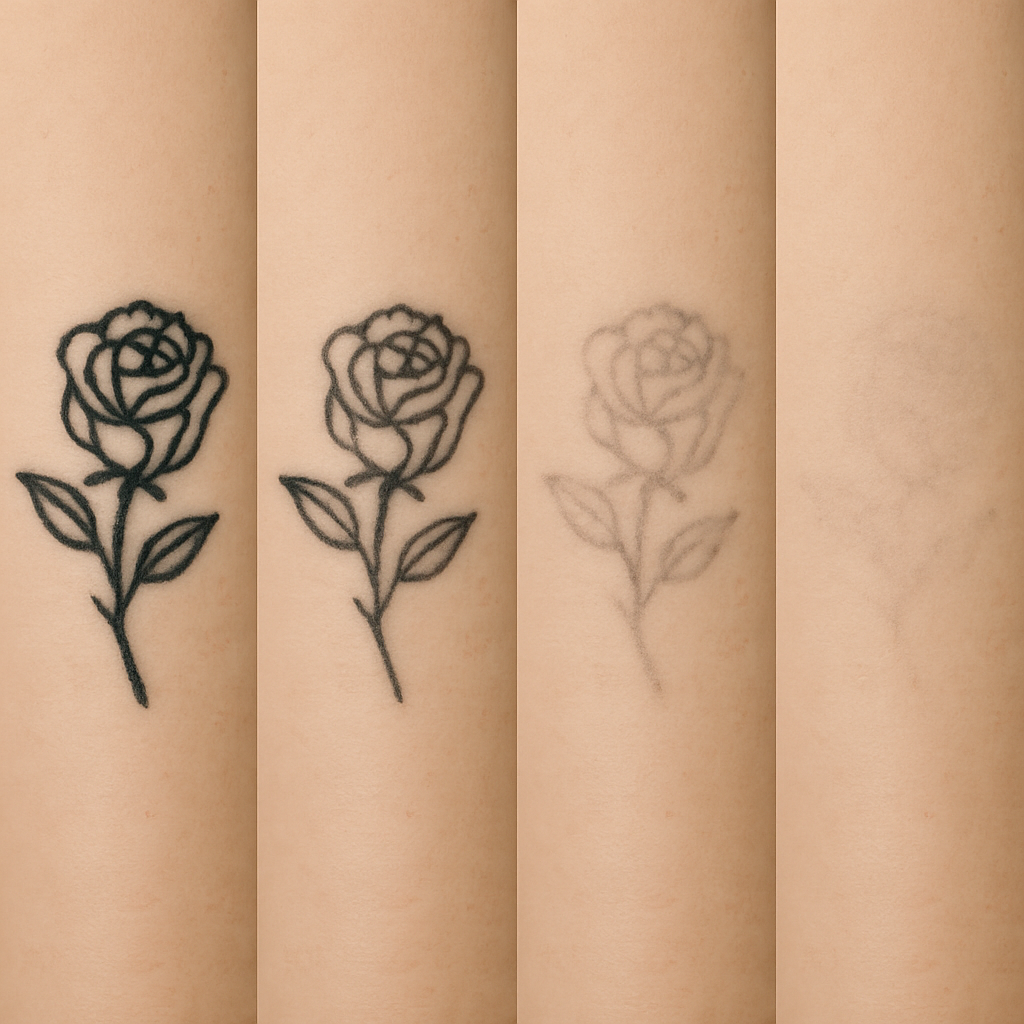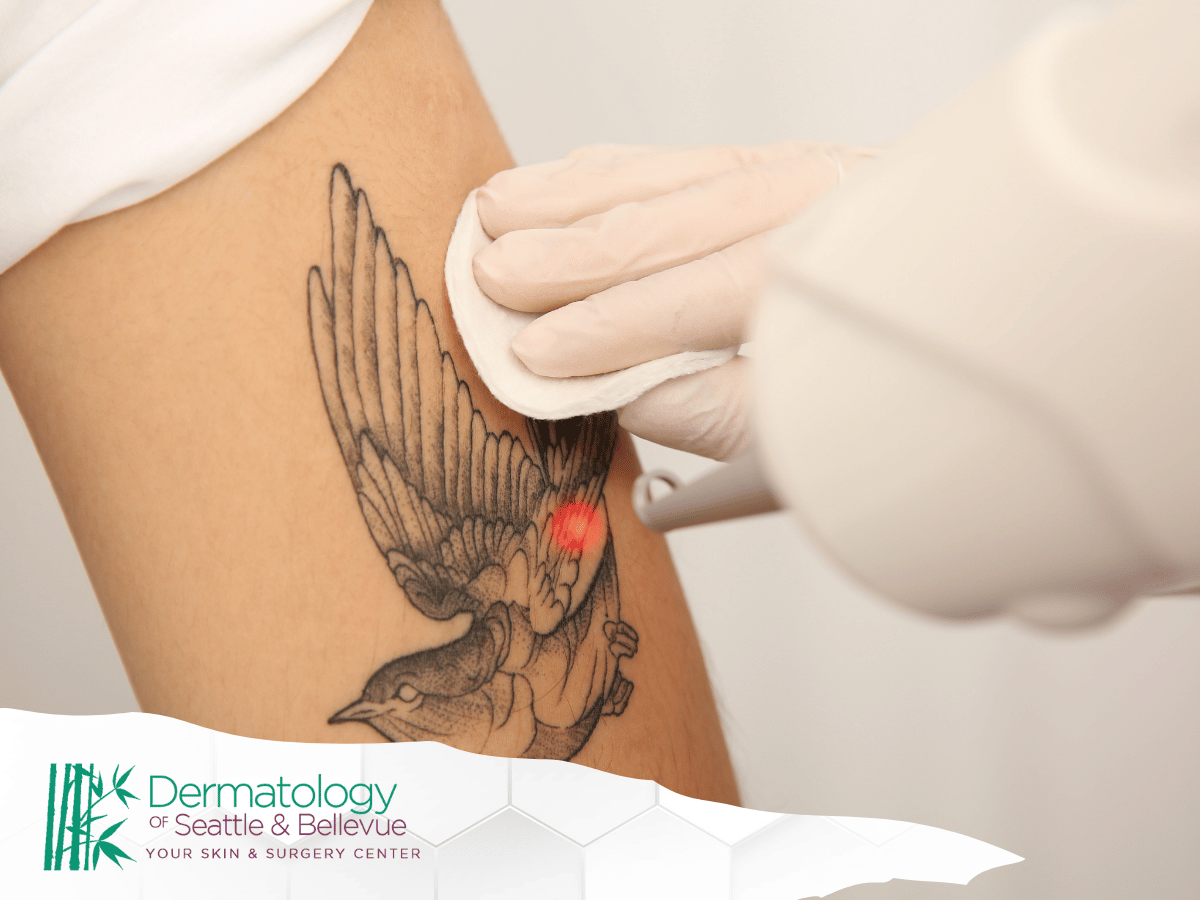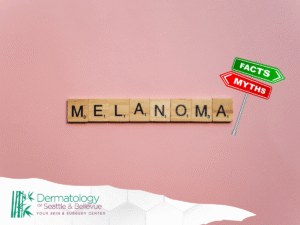Tattoo removal has become an increasingly popular choice for individuals seeking to erase their past ink decisions. Whether it’s a change in personal style or a desire to remove a reminder of the past, professional tattoo removal services are in high demand. In this article, we aim to answer some of the most common questions about tattoo removal, focusing on what works and what doesn’t in our clinic. Our goal is to provide you with clear, straightforward information about the different tattoo removal techniques available today.

Tattoo removal involves breaking down the ink particles in your skin so that your body can naturally remove them. This complex process requires understanding the science behind it to choose the best method for individual needs. There are several methods available, but not all are created equal. The effectiveness of a technique depends on several factors, including the type of ink used, the depth of the tattoo, and the individual’s skin type.
The Science of Ink and Skin
The science behind tattoo removal starts with understanding how tattoos are made. Tattoos are created by injecting ink into the dermis, the second layer of skin. This placement ensures permanence, but it also makes removal challenging. Each ink particle is encapsulated within the skin, which is why the removal process requires breaking these particles down. Different inks have different compositions, affecting how they respond to removal techniques. For instance, metallic inks may react differently to laser treatments compared to organic inks.
The Role of the Immune System
The body’s immune system plays a crucial role in tattoo removal. Once the ink particles are broken down, the immune system is responsible for eliminating these smaller particles from the skin. The speed and effectiveness of this process can vary based on individual health factors. A strong, healthy immune system can expedite the removal process, making certain lifestyle choices—such as maintaining a balanced diet and staying hydrated—integral to the success of the procedure.
Choosing the Right Clinic
Selecting the right clinic for tattoo removal is as important as understanding the process itself. A reputable clinic will offer a range of options and tailor the approach to fit the client’s specific needs. Experienced professionals will evaluate the tattoo’s characteristics and the client’s skin type before recommending a suitable method. It’s crucial to ensure the clinic uses the latest technology and follows strict safety protocols to minimize risks and maximize results.
What Are the Most Common Tattoo Removal Techniques?
Tattoo removal techniques vary widely, with each method offering distinct advantages and limitations. Understanding these differences can help individuals make informed decisions about their removal journey.
Laser Tattoo Removal
Laser tattoo removal is the most popular and effective method for removing unwanted tattoos. It works by using high-intensity light beams to break down the ink particles in the skin. The laser targets the ink, causing it to shatter into smaller pieces that the body can naturally eliminate.
How It Works
The laser emits short pulses of light that penetrate the skin. Each pulse targets the tattoo ink without damaging the surrounding skin. This precision is key to the success of laser treatments. Over several sessions, the ink breaks down, and the body gradually removes it. Different lasers are used for different ink colors, such as Q-switched lasers for darker inks and picosecond lasers for stubborn lighter colors.
Effectiveness
Laser tattoo removal is highly effective, especially for black and dark-colored tattoos. However, lighter colors such as yellow and green can be more challenging to remove and may require more sessions. The success of the treatment also depends on the tattoo’s age, with older tattoos often being easier to treat due to ink degradation over time. Consistency in attending sessions and following aftercare instructions significantly enhances outcomes.
Benefits and Drawbacks
One of the primary benefits of laser tattoo removal is its precision, which minimizes damage to the surrounding skin and reduces the risk of scarring. However, the process can be time-consuming, requiring multiple sessions to achieve optimal results. It’s also important to consider the cost, as each session can be expensive, adding up over time. Despite these drawbacks, many find the results well worth the investment.
Intense Pulsed Light Therapy (IPL)
Intense Pulsed Light Therapy (IPL) is another method used for tattoo removal, though it’s less common than laser treatment. IPL uses a broad spectrum of light to target the ink particles.
How It Works
Similar to laser removal, IPL delivers intense pulses of light to the skin. These pulses break down the ink, which is then absorbed by the body. IPL machines utilize a broad-spectrum light rather than the monochromatic light used in lasers, making it less precise but potentially effective for certain cases. IPL is generally more effective on lighter skin tones and less effective on darker skin tones due to the risk of pigmentation changes.
Effectiveness
While IPL can be effective for some tattoos, it is generally less effective than laser removal. It may also be more expensive and requires more sessions to achieve desired results. The broad-spectrum light can sometimes lead to uneven results, particularly with multicolored tattoos. Patients considering IPL should have realistic expectations and understand that complete removal may not be possible with this method.
Considerations and Cost
Choosing IPL for tattoo removal involves weighing its benefits against potential drawbacks. While it can be a viable option for certain skin types and ink colors, the lack of precision compared to laser treatments is a significant consideration. Additionally, IPL sessions can be more costly, and the need for numerous sessions can quickly escalate the overall expense. Consulting with a specialist can help determine if IPL is a suitable choice for your specific tattoo and skin type.
Dermabrasion
Dermabrasion is a more invasive technique that involves physically sanding down the skin to remove the upper layers where the tattoo ink resides.
How It Works
A high-speed rotary device with an abrasive brush or wheel is used to remove the top layers of the skin. This process is akin to a deep exfoliation, and as the skin heals, the body may naturally remove some of the ink. Dermabrasion requires skill and precision to avoid excessive skin damage and is generally performed under local anesthesia to minimize discomfort.
Effectiveness
Dermabrasion can be effective for small tattoos, but it is less precise and can cause scarring. It is generally not recommended for large or complex tattoos due to the potential for uneven results and extended healing times. The success of dermabrasion largely depends on the tattoo’s depth and the individual’s skin healing response.
Risks and Recovery
The invasive nature of dermabrasion means there are higher risks involved, including scarring and infection. Recovery can be lengthy, with patients needing to follow strict aftercare protocols to prevent complications. Despite these risks, dermabrasion can be a suitable option for those unable to undergo laser treatments or seeking to remove small, superficial tattoos. Consulting with a dermatologist can provide further insight into whether dermabrasion is an appropriate choice.
What Are the Risks and Side Effects of Tattoo Removal?
Every tattoo removal method carries some risk of side effects. Understanding these risks is crucial for making an informed decision and preparing for the removal process.
Common Side Effects
Common side effects of tattoo removal include redness, swelling, blistering, and temporary changes in skin pigmentation. These side effects are typically mild and resolve on their own with proper care. Redness and swelling are part of the body’s natural healing response, while blistering is a sign that the skin is reacting to the treatment. Proper aftercare, including keeping the area clean and moisturized, can help mitigate these effects.
Risks of Laser Tattoo Removal
- Hyperpigmentation or Hypopigmentation: These are changes in skin color that can occur after treatment. The risk is higher in individuals with darker skin tones, as the laser may affect melanin production. Proper laser settings and experienced practitioners can minimize this risk.
- Scarring: Rare but possible if the skin is not properly cared for post-treatment. Following aftercare instructions, such as avoiding sun exposure and not picking at scabs, can reduce this risk.
- Infection: As with any procedure that affects the skin, there’s a slight risk of infection. Keeping the treated area clean and adhering to prescribed aftercare routines can prevent infections.
Risks of IPL and Dermabrasion
- Scarring and Infection: More common with dermabrasion due to the invasive nature of the procedure. Proper technique and post-treatment care are essential to minimize these risks.
- Ineffectiveness: IPL may not effectively remove all ink colors and is generally less effective than laser removal. Patients should be aware of the limitations and manage expectations accordingly.
- Longer Recovery Times: Especially with dermabrasion, recovery can be extensive, and the skin may take weeks to heal fully. Patience and adherence to aftercare instructions are crucial during this period.
What Determines the Success of Tattoo Removal?
Several factors affect the success of tattoo removal, making each case unique.
Tattoo Age and Depth
Older and more superficial tattoos are easier to remove. Over time, tattoos naturally fade as the body’s immune system gradually breaks down the ink particles. The depth of the tattoo also plays a significant role; tattoos closer to the skin’s surface are generally more responsive to treatments. Assessing a tattoo’s age and depth helps professionals tailor the removal process for better outcomes.
Ink Colors
Ink colors significantly impact removal success. Black and dark blue inks are easier to remove than lighter colors like yellow and green, which can reflect laser light, making them harder to break down. Multicolored tattoos may require different lasers to target each color effectively, increasing the complexity of the treatment. Understanding the tattoo’s color composition allows for a strategic approach, utilizing specific lasers for optimal results.
Skin Type and Location
Skin type influences how well a tattoo responds to removal. Lighter skin tones tend to respond better to laser treatments, while darker skin tones may require more sessions to avoid pigmentation issues. Tattoo location also matters; tattoos closer to the heart often fade faster due to better circulation, which aids in the removal process. Considering skin type and tattoo location ensures a personalized approach, enhancing the likelihood of successful removal.
How Many Sessions Are Needed?

The number of sessions required depends on the tattoo’s size, color, and depth, as well as the chosen removal method. On average, laser tattoo removal requires 6-10 sessions, spaced 4-8 weeks apart, to achieve optimal results. Patience is key, as complete removal can take several months or even over a year.
Factors Influencing Session Count
Several factors influence the number of sessions needed for tattoo removal. Larger tattoos with intricate designs typically require more sessions than small, simple ones. The ink’s composition and the tattoo’s location also play a role, with certain areas of the body responding faster to treatments. Each session builds upon the last, gradually fading the tattoo until it becomes less visible or completely removed.
Importance of Consistency
Consistency in attending scheduled sessions is crucial for effective tattoo removal. Each session targets the ink particles, breaking them down further, and the body’s immune system continues to work between appointments. Skipping sessions or delaying treatments can prolong the process and affect outcomes. Adhering to the recommended schedule ensures steady progress and enhances the likelihood of complete removal.
Managing Expectations
Managing expectations is vital when undergoing tattoo removal. While some individuals may see significant fading after a few sessions, others may require more time. Complete removal isn’t guaranteed for all tattoos, especially those with complex colors or deep ink. Understanding the potential outcomes and being patient throughout the process can help individuals maintain a positive outlook and appreciate the gradual progress.
Is Tattoo Removal Painful?
Pain tolerance varies, but most people describe laser tattoo removal as feeling like a rubber band snapping against the skin. Clinics often use numbing creams or cooling devices to minimize discomfort during the procedure.
Pain Management Techniques
To manage discomfort during tattoo removal, clinics employ various techniques. Numbing creams are commonly applied before treatment to desensitize the skin, while cooling devices, such as chilled air or ice packs, are used during and after the procedure to soothe the area. These methods significantly reduce pain levels, making the process more tolerable for clients with varying pain thresholds.
Individual Pain Thresholds
Individual pain thresholds play a significant role in how tattoo removal is perceived. Some individuals may experience minimal discomfort, while others may find the process more painful. Factors such as tattoo location, size, and skin sensitivity can influence pain levels. Communicating with the practitioner about pain concerns can help tailor the experience and ensure appropriate pain management strategies are in place.
Psychological Aspects of Pain
The psychological aspect of pain should not be underestimated. Anxiety or fear of the procedure can heighten the perception of pain, making relaxation techniques beneficial. Deep breathing, meditation, or listening to calming music during sessions can help alleviate anxiety and create a more comfortable experience. Understanding that discomfort is temporary and part of the process can also ease psychological stress.
Conclusion
Tattoo removal is a personal decision, and choosing the right method is crucial for achieving the best results. Laser tattoo removal stands out as the most effective and safest option for most individuals. However, it’s essential to consult with a professional to determine the best approach for your specific tattoo and skin type. Remember, successful tattoo removal takes time and patience, but with the right technique and care, it is possible to leave your unwanted ink in the past.
The Importance of Professional Guidance
Professional guidance is invaluable in the tattoo removal journey. Experienced practitioners provide insights into the most suitable methods, manage expectations, and ensure the process is as smooth as possible. They offer personalized care plans, taking into account individual factors such as skin type, tattoo characteristics, and health conditions, ensuring a tailored approach for each client.
Embracing the Journey
Embracing the tattoo removal journey involves understanding that it is a process requiring time and commitment. Each session brings individuals closer to their desired outcome, and maintaining a positive attitude can make the experience more rewarding. Celebrating small milestones, such as noticeable fading, can boost motivation and reinforce the decision to pursue tattoo removal.
Moving Forward with Confidence
Leaving unwanted ink in the past allows individuals to move forward with confidence. Whether seeking a fresh start or aligning appearance with personal values, successful tattoo removal can enhance self-esteem and provide a sense of liberation. By choosing the right method and adhering to professional advice, individuals can achieve satisfying results and embrace new possibilities.





